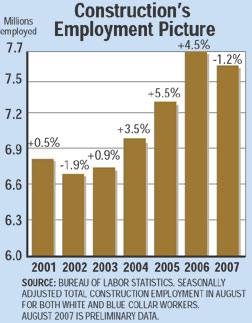A steady flow of work is driving high demand for construction trades, as well as the highest wage and benefit increases in recent history for both union and open-shop workers nationwide. Wage and benefit settlements for union trades have so far produced an average first year increase of $1.90, or 4.7%, according to the Construction Labor Research Council. That hike exceeds the $1.74 recorded during the same period in 2006, a 4.6% increase.
Labor agreements for all of 2006 saw average increases of 4.5% for the first year, the highest percentage increase since 1989, says CLRC. But preliminary data suggests that 2007 could eclipse that record, says Bob Gasperow, council executive director. “Since 1999, [first year] increases have stayed steadily above 4%, but these [increases] are as high as it’s been in 10 years,” he adds.
Likewise, the open shop is making significant gains. Last year, nonunion workers averaged increases of 4.94%, according to data collected by Personal Administration Services. PAS President Jeff Robinson says recent pay hikes are on par with those seen in 1999 and 2000, when wages rose at the highest rates in two decades. Based on data compiled for 2007 thus far, Robinson says he expects this year to top 2006. “We’re looking at higher increases in 2007 and 2008,” he says. “There’s no retreat in sight.”
The highest increases recorded by PAS were seen in southern states, where wages rose on average by about 5.5%, driven by industrial investment to repair hurricane-damaged or outdated facilities and meet growing demand for refining capacity. Robinson says many contractors report wage increases of 20% for heavy industrial work around Baton Rouge and Lake Charles in Louisiana and Beaumont, Texas.
Robinson says the greatest strain is on supply of skilled trades such as pipefitters, boilermakers, welders, electricians, millwrights and structural ironworkers. To draw workers from other areas, per diems have risen dramatically. Many firms now offer daily rates of $70 to $90, nearly twice the national average, says PAS.
Bill Bobo, executive director of the Houston Business Roundtable, says some owners in his area report total compensation hikes of 30% to 50%, including wages, bonuses and incentives. The result is overall labor increases that harken back to the 1960s and 1970s when labor demand was at a record high, he says.
Employers “are getting creative in how they compensate construction workers now,” he adds. “Many are reluctant to do wholesale increases in direct wages, so they offer things like completion bonuses to make the work attractive.”
And demand is only going to increase. Business groups in eastern Texas and Louisiana are forecasting steady increases for heavy industrial labor through 2008. Owners near New Orleans, Houston, Lake Charles, Baton Rouge, Brazoria City, Texas, and the Texas “Golden Triangle” area of Beaumont, Port Arthur and Orange, are forecasting a need for 18,800 construction workers in October, say regional groups affiliated with the national Business Roundtable. By the end of 2008, demand is expected to rise by nearly one-third to 24,864.
Adding to immediate demand is plant turnaround work scheduled by many refineries for this winter, a shutdown period for maintenance and construction. In July, those areas reported total demand of 5,050 workers for turnaround projects. By next March, demand could hit 19,199. Bobo says some employers are turning to labor brokers to fill the void with temporary foreign workers. “I spoke recently with a company that is bringing in skilled Filipino welders and offering them housing, transportation and other needs to stay here for six months,” he says. “We expect to see a lot more of that with workers also coming in from India, South America and Central America.”
Bobo says worker demand will continue to balloon with energy demand. “With all of the powerplants being planned, we’re talking about another 100,000 construction workers needed in the South in the next decade,” he says. “The pipeline is pretty empty and it doesn’t look promising that we’ll fix it anytime soon.”
Other sectors may also start to feel the drain. Robinson says there could be crossover demand for commercial sector crafts such as electricians, lured by higher pay on industrial projects. “If you ask a commercial contractor what their wage increases have been in Houston, they’ll say 4%,” he explains. “Ask a heavy industrial contractor and they’ll say 15%.”
Demand could hit critical levels if predictions about large-scale reconstruction of the Gulf Coast come to pass, says Don Whyte, president of the National Center for Construction Education and Research in Gainesville, Fla. “When the rebuilding ramps up, you’ll see even greater stresses on wages to increase,” he says. “We’re already beginning to hear the warnings all over the region.”
The depressed single-family housing market has done little to relieve pressure on the labor shortages for construction of private nonresidential building and public works. Overall, total construction employment is down just 1% from last year’s record peak. While employment in the housing market was down 3.2%, it dropped only 0.7% in the nonresidential sector. In the heavy and civil markets, construction employment increased 1.1% over a year ago. On the flip side of the employment coin, construction’s unemployment rate dropped to 5.3% in August, after averaging 6.7% last year. |
 Related Links:
Related Links: 

Post a comment to this article
Report Abusive Comment